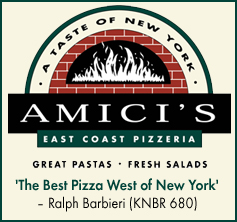| |
|

The Inquisitive Traveler
The darlings of the Dalmatian Coast
By Patty Burness
Photos by Patty Burness
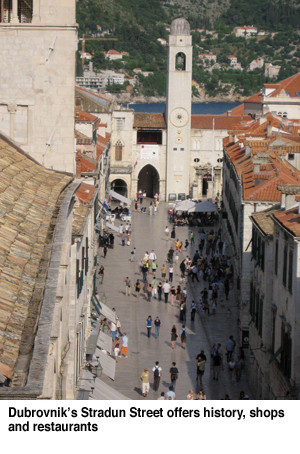
If you’re looking for a Riviera-inspired vacation but with a better exchange rate, try Croatia. The Dalmatian Coast, which lies along the Adriatic Sea, is alluring. (And yes, it’s where the breed of dog originates.) I recently visited this beautiful country — rebuilt and majestic after occupation and war. First, a little history.
Prior to the end of World War I, Croatia was led by Hungarians, Turks, Venetians, and the French. In 1918 it became part of the Kingdom of Serbs, Croats and Slovenes, later named Yugoslavia. During World War II, Germans and Italians occupied Yugoslavia, and in 1945 the Republic of Yugoslavia was declared with Croatia inside its borders. After Croatia proclaimed independence in 1991, a Serbian-led rebellion resulted in one-third of Croatian territory becoming occupied. The following year, 1992, the Republic of Croatia joined the United Nations, and in 1998 the last occupied region of Croatia joined with the rest of the country.
My journey began in Dubrovnik, a city that early on was under threat from earthquakes, fires and wars. It rose to prominence as a maritime trade center in the Middle Ages, rivaling only Venice, and was designated as a UNESCO World Heritage Site in 1979. When Croatia declared its independence, Serbian and Montenegrin gunners bombarded Dubrovnik in response. With assistance from Croatian authorities and UNESCO, this great walled city, or “Pearl of the Adriatic” as it’s often called, was rebuilt in the ancient style that gives it a strong sense of history as well as magnificence.
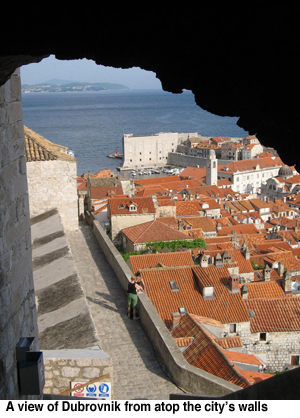 I checked into the Excelsior Hotel, perched on a hillside just outside the city’s walls. This modern five-star property has everything a traveler needs, but most important, it’s got knockout views of Dubrovnik. Choices abound: Swim in the Adriatic or the hotel’s gorgeous pool, enjoy one of their restaurants, indulge in spa treatments, or head to the city center and start exploring. I chose walking and after five minutes had an up-close view of the harbor and the city’s massive walls. I checked into the Excelsior Hotel, perched on a hillside just outside the city’s walls. This modern five-star property has everything a traveler needs, but most important, it’s got knockout views of Dubrovnik. Choices abound: Swim in the Adriatic or the hotel’s gorgeous pool, enjoy one of their restaurants, indulge in spa treatments, or head to the city center and start exploring. I chose walking and after five minutes had an up-close view of the harbor and the city’s massive walls.
Pass through a tower gate and you’re immediately part of Dubrovnik’s history. Just inside the wall is Stradun Street, a main artery lined with shops, restaurants and churches, much the way it was long ago. Other highlights include the 18th century Church of Saint Blaise, built for Dubrovnik’s patron saint. Rector Palace, from the Gothic Renaissance period, houses a museum of the city’s history. And the Sponza Palace, where you’ll find the National Archives, survived the 1667 earthquake. Immediately outside the wall on the north side is Fortress Lovrijenac. Sitting atop massive rocks, this fortification protected the city from invasion. An exhilarating mile-long walk atop the wall yields panoramic views of the shimmering blue Adriatic, and the red-tiled roofs of Dubrovnik’s buildings will have you oohing and ahing the whole way.
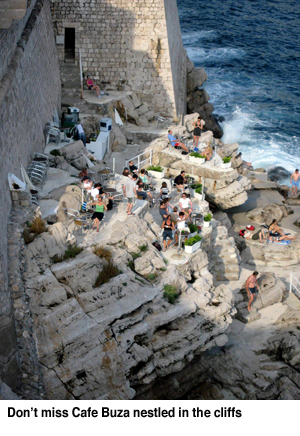 There’s lots of good eating and drinking inside and outside the city walls, but a favorite is Kamenice (located inside on the square where the farmers’ market is held). Enjoy delicious coffee in the morning and feast on delectable oysters and mussels throughout the day. And when the sun is setting, Cafe Buza, nestled in the cliffs, is a terrific place for cocktails. After 9 p.m., try Jazz Caffee Troubadour where local Nick Bresco croons like Sinatra, and others join the band to heat up the late night with a cool Latin jazz vibe. There’s lots of good eating and drinking inside and outside the city walls, but a favorite is Kamenice (located inside on the square where the farmers’ market is held). Enjoy delicious coffee in the morning and feast on delectable oysters and mussels throughout the day. And when the sun is setting, Cafe Buza, nestled in the cliffs, is a terrific place for cocktails. After 9 p.m., try Jazz Caffee Troubadour where local Nick Bresco croons like Sinatra, and others join the band to heat up the late night with a cool Latin jazz vibe.
From Dubrovnik, it’s only about a 30-mile drive north along the coast to Ston, home of the longest fortification wall in Europe (second to China), sea salt and oysters. The wall was built to secure the salt farms that produce 2,000 tons of salt per year in the same way today as it was done in the Middle Ages. But salt needs to be sprinkled on something, so Vila Koruna in Mali Ston was on tap for lunch. Their motto is “eat oysters, love longer.” The food is superb and most of it comes from the sea: mussels in wine and garlic, squid risotto, tagliatelle with shrimp, and of course, dozens and dozens of raw Komenice oysters. Choose a local wine for your meal — along the coast, Grasevina and Posip are popular whites and Dingac, Postup and Plavac Mali are common reds.
Croatia has more than a thousand islands and it’s impossible to leave the country without visiting at least one. I chose Korcula, but first drove from Ston across the Piljesac peninsula along the scenic 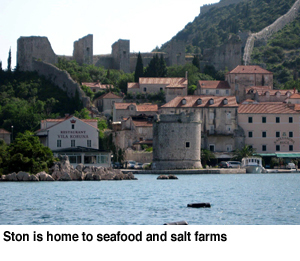 route passing vineyards and a stunning coastline. Stop and sample the wine, but don’t miss the ferry that leaves from Orebic. The Korcula crossing is only 15 minutes (ferries carry passengers and cars). route passing vineyards and a stunning coastline. Stop and sample the wine, but don’t miss the ferry that leaves from Orebic. The Korcula crossing is only 15 minutes (ferries carry passengers and cars).
Korcula is Croatia’s sixth largest island, about 30 miles long; it takes an hour to drive from one end to the other. Relax on red sand beaches near the town of Lumbarda (on the eastern tip) or explore the old town of Korcula (near the marina on the western side). The old town was built in the 16th century, and walls and towers fortify it, too. Throughout the centuries, the islanders have been fishermen, growers of grapes and olives, shipbuilders, stonecutters, and artists. Gothic and Renaissance buildings, palaces, churches, and squares celebrate these talents. Marco Polo is a local hero; learn about his life at a museum and family house.
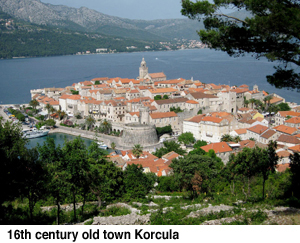 Hotel Marko Polo, on a hillside overlooking the marina, is perfectly situated for walking to the old town or roaming the western end of the island. No matter, wherever you look, the sea is azure, the roofs are red, and the sunshine is golden. When it’s time to eat, stroll to Kanavelic, next to one of the towers in old town. It’s casual with a wonderful patio and a fabulous view. The local seafood — squid, scampi, oysters — is fresh, succulent and perfect with Grk, a local white wine. Hotel Marko Polo, on a hillside overlooking the marina, is perfectly situated for walking to the old town or roaming the western end of the island. No matter, wherever you look, the sea is azure, the roofs are red, and the sunshine is golden. When it’s time to eat, stroll to Kanavelic, next to one of the towers in old town. It’s casual with a wonderful patio and a fabulous view. The local seafood — squid, scampi, oysters — is fresh, succulent and perfect with Grk, a local white wine.
Croatia is a long haul, but worth it. The views, the history, the warmth of the people, and of course the food, will mesmerize you. Put Croatia on your “must visit” list and you’ll be excited with what you find.
Essentials
Getting There
Dalmatian Coast, Croatia: Just under a 30-hour flight from San Francisco to Dubrovnik; www.expedia.com/gogreen, www.eco.orbitz.com.
Tourist Information: www.croatia.hr, www.travel-2-croatia.com, www.korcula-croatia.com, www.korculainfo.com/ferries-korcula.
Where to Stay
(All prices calculated at 1 U.S. dollar = 4.97 kuna)
Excelsior Hotel & Spa: Frana Supila 12, Dubrovnik, 00385-20-353-353, www.hotel-excelsior.hr; sea view rooms from $315.
Hotel Marko Polo: Setaliste F. Krsinica 102, Korcula, 00385-20-726-306, www.korcula-hotels.com; sea view rooms from $126.
Where to Eat
Kamenice: Gundulićeva poljana 8, Dubrovnik, 00385-20-323-682; coffee $1.50, oysters $1.80 each, mussels $10.
Cafe Buza: Crijevicava 9, Dubrovnik, 00385-98-361-934; beer, wine and cocktails from $6.
Jazz Cafe Troubadour: Bunićeva poljana 2, Dubrovnik, 00385-20-323-476; beer, wine and cocktails from $6.
Vila Koruna: Mali Ston, 00385-20-754-999; cold starters from $4, hot starters and fish and crab dishes from $8.
Kanavelic: Sveta Barbara 12, Korcula, 00385-20-711-800; fish and seafood dishes from $15, wines by the bottle from $15.
Must Try
La Fresh: Biodegradable toiletry wipes are TSA-approved, simple to use, and don’t take up room in a bag. A variety of products are available; sunscreen towelettes with SPF 30 are good any time of the year; www.lafreshgroup.com.
Patty Burness is the travel writer for Northside San Francisco. E-mail: patty@northsidesf.com



|
|
|
|








 I checked into the Excelsior Hotel, perched on a hillside just outside the city’s walls. This modern five-star property has everything a traveler needs, but most important, it’s got knockout views of Dubrovnik. Choices abound: Swim in the Adriatic or the hotel’s gorgeous pool, enjoy one of their restaurants, indulge in spa treatments, or head to the city center and start exploring. I chose walking and after five minutes had an up-close view of the harbor and the city’s massive walls.
I checked into the Excelsior Hotel, perched on a hillside just outside the city’s walls. This modern five-star property has everything a traveler needs, but most important, it’s got knockout views of Dubrovnik. Choices abound: Swim in the Adriatic or the hotel’s gorgeous pool, enjoy one of their restaurants, indulge in spa treatments, or head to the city center and start exploring. I chose walking and after five minutes had an up-close view of the harbor and the city’s massive walls.  There’s lots of good eating and drinking inside and outside the city walls, but a favorite is Kamenice (located inside on the square where the farmers’ market is held). Enjoy delicious coffee in the morning and feast on delectable oysters and mussels throughout the day. And when the sun is setting, Cafe Buza, nestled in the cliffs, is a terrific place for cocktails. After 9 p.m., try Jazz Caffee Troubadour where local Nick Bresco croons like Sinatra, and others join the band to heat up the late night with a cool Latin jazz vibe.
There’s lots of good eating and drinking inside and outside the city walls, but a favorite is Kamenice (located inside on the square where the farmers’ market is held). Enjoy delicious coffee in the morning and feast on delectable oysters and mussels throughout the day. And when the sun is setting, Cafe Buza, nestled in the cliffs, is a terrific place for cocktails. After 9 p.m., try Jazz Caffee Troubadour where local Nick Bresco croons like Sinatra, and others join the band to heat up the late night with a cool Latin jazz vibe. route passing vineyards and a stunning coastline. Stop and sample the wine, but don’t miss the ferry that leaves from Orebic. The Korcula crossing is only 15 minutes (ferries carry passengers and cars).
route passing vineyards and a stunning coastline. Stop and sample the wine, but don’t miss the ferry that leaves from Orebic. The Korcula crossing is only 15 minutes (ferries carry passengers and cars). Hotel Marko Polo, on a hillside overlooking the marina, is perfectly situated for walking to the old town or roaming the western end of the island. No matter, wherever you look, the sea is azure, the roofs are red, and the sunshine is golden. When it’s time to eat, stroll to Kanavelic, next to one of the towers in old town. It’s casual with a wonderful patio and a fabulous view. The local seafood — squid, scampi, oysters — is fresh, succulent and perfect with Grk, a local white wine.
Hotel Marko Polo, on a hillside overlooking the marina, is perfectly situated for walking to the old town or roaming the western end of the island. No matter, wherever you look, the sea is azure, the roofs are red, and the sunshine is golden. When it’s time to eat, stroll to Kanavelic, next to one of the towers in old town. It’s casual with a wonderful patio and a fabulous view. The local seafood — squid, scampi, oysters — is fresh, succulent and perfect with Grk, a local white wine.